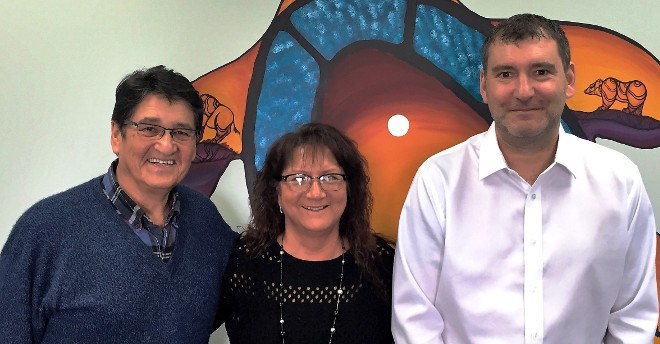A national skills inventory for Indigenous workers that’s been a decade in the making is inching closer to being rolled out across Canada.
Working Warriors is an online database that aims to catalogue Indigenous workers — along with their contact information, skills and certifications, experience and interests — to make it easier for them to be hired on projects across the country.
The idea was first conceived by Jamie Saulnier, the Ignace-born president and co-founder of Running Deer Group of Companies, comprised of various companies focused on securing employment and economic development opportunities for Indigenous communities, EPC industrial construction, and labour solutions in various fields and occupations.
After struggling to find Indigenous workers to fulfill job vacancies on construction projects, Saulnier was determined to find a solution.
“If you're ever an individual that spends time in the (Indigenous) communities, and you see the potential that's out there, and you also see some of the hardships that are happening in our communities in Canada, and you get to know the people, you can't help but want to push this forward,” Saulnier said. “You can't help it.”
Ten years after he first embarked on the idea of a database of Indigenous workers and their skills, the idea is finally gaining some real traction amongst the communities, industry, and government.
Teaming up with the Joint Economic Development Initiative (JEDI), an Indigenous not-for-profit organization dedicated to working with partners to foster Indigenous economic development in New Brunswick, Saulnier spent a year working to integrate every Indigenous community in New Brunswick into the database.
To date, about 75 per cent of the province’s communities have been added, giving each access to a personalized human resources system.
It includes all the data about a community, including its workers, their education, their skills and training, as well as any ancillary information that would benefit companies working in an Indigenous community, such as a list of available hotels, gas stations and restaurants.
Other communities are coming on board, and pilot projects done over the last 10 years show that it’s working: Indigenous workers are finding employment through the platform.
Across communities and across industry, stakeholders have agreed that Indigenous workers represent an untapped workforce in Canada, but a common stumbling block prevails: who are these workers? Where do they live, and what are their skills? And how do you get in contact with them?
“Every single project we’ve been on, every employer that I’ve talked to, every community that I’ve talked to, it really was part of the biggest barrier that we face in Canada today: we still don’t have a very good understanding of our Indigenous workforce,” Saulnier said.
“If you’re told to engage with the workforce, and if you don’t know who that is, it makes it difficult.”
Complementary to the Working Warriors database is the National Association of Indigenous Workers (NAIW), a non-profit Indigenous organization through which employers can seek out employees, communities can track their analytics, and individuals can look for work or promote themselves via social media.
In May, the initiative got a big boost of confidence when it forged a strategic alliance with Bird Construction, one of Canada’s largest construction companies.
James Thorbourne, Bird’s vice-president of Indigenous business relations, said the Working Warriors platform aligns well with the goals of the construction company’s National Indigenous Engagement Policy, which it’s developed over the last 18 months.
“As part of our National Indigenous Engagement Policy, we seek to be proactive in hiring Indigenous workers, especially in our projects that are on traditional lands of various Indigenous communities,” Thorbourne said.
Bird has had success working with some Indigenous communities — in particular, Inuit communities in northern Labrador and the Whitecap Dakota First Nation in Saskatchewan — but Thorbourne contends there is always room for improvement.
“There are certainly pockets of successes, but we also see the Indigenous market as an emerging market, and we need to get good at working with communities that aren't as prepared, perhaps, as the Labrador Inuit or the Whitecap Dakota in being able to serve up their workforce.”
In general, he said, communication between Indigenous communities and industry needs to improve.
Indigenous communities often don’t have the capacity to compile information about their workforce, while companies aren’t good at accessing that information.
Miscommunication ensues, putting up barriers to a good working relationship.
Bird sees the Working Warriors database as a tool that can help the company improve those relationships, Thorbourne added.
“I think it’s a helpful approach, and one that is not out there yet, so it’s a new, innovative approach that tries to bridge that communication gap,” he said.
To roll out the Working Warriors initiative nationwide, Saulnier said it will require between $2 million and $5 million in capital.
He’s optimistic that ongoing meetings with key leaders at FedNor, the Indigenous Liberal Caucus, Employment and Social Development Canada, and Indigenous and Northern Affairs Canada could further advance the project. Offset Market Exchange (OMX) has also come on board to assist with procurement opportunities.
By year’s end, Saulnier wants to have every Indigenous community in North America registered, and he’s already working with stakeholders in the United States, where he hopes to start more pilot projects.
“For me, Indigenous culture is Canada's culture, it's my culture, and in a lot of ways I see that culture is both suffering and has so much tremendous potential,” Saulnier said.
“So, for me, I just keep pushing, and every time a new person gets a job, it's very gratifying and it proves that this can work.”




